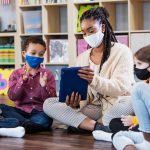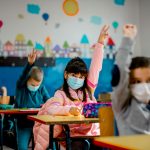The pandemic has presented a variety of different challenges, many of which are exhausting to cope with. The University of Connecticut’s Alumni Relations hosted a panel titled “Not Burnout, Betrayal: The Pandemic’s Impact on Working Mothers.” Panelists, along with an array of other women, discussed various struggles that mothers are facing today.
“As many schools in the U.S. figure out how to safely and fully resume in-person instruction, much of the focus is on vaccinations. But there’s another type of ‘vaccine’ that may be beneficial for some returning K-12 students that could be overlooked. Those are known as ‘behavioral vaccines.'”
“As many schools in the U.S. figure out how to safely and fully resume in-person instruction, much of the focus is on vaccinations,” says Neag School Board of Trustees Distinguished Professor Sandra Chafouleas. “But there’s another type of ‘vaccine’ that may be beneficial for some returning K-12 students that could be overlooked. Those are known as ‘behavioral vaccines.'”
T. J. McKenna’s career revolves around one simple question: how can we make science meaningful, engaging, and relevant to our everyday lives? He began that career as an animal behaviorist and entomologist. But as a grad student, McKenna says, he realized that the audience for research papers is relatively limited and he sought ways for sharing his passion for science with a broader audience.
Says UConn’s Rachael Gabriel, associate professor of literacy education: “Since schools shut down, students have been called the ‘hobbled’ generation and the ‘Covid class.’ They have been told they have or will experience Covid-related slides, losses, gaps, and other deficiencies that are ‘disastrous’.”
She’s quick to add: “They should be told the opposite,” considering the challenges they have faced and the learning adaptations they have made.

For educators, families, and communities, April is bringing a welcome sign of hope to a year of unchartered challenges as political unrest, COVID-19, social and racial disparities, and violence have disrupted and dismantled our schools’ traditional approach to education. The appointment of Miguel A. Cardona as the 12th Secretary of Education and the passing of the American Rescue Plan of 2021 does make it feel like spring, in fact, has sprung. The possibility of equitable school environments for our nation’s children appears tangible, however, recovery must attend to more than filling holes with intent to return to a “new normal.”
Students desperately need support as they try to overcome current challenges to academic learning, physical health, and social-emotional connection. Meanwhile, school leaders must focus on coordinating policies and practices that put equitable structures in place for every child. While the necessary federal leadership and funding provide necessary first steps to tackling multiple points of support to the education infrastructure, we propose that schools reopen not with a “new normal,” but a “better normal” — one where we carry out only a few highly effective actions really well.
“As education leaders navigate our emerging new reality, it is critical that their decisions, and guidance that informs their decisions, be effective and usable. The evolving education environment demands nimble decision-making that relies on the best available knowledge,” say Neag School’s George Sugai and Sandra Chafouleas.
Lisa Sanetti said the “levels of heightened stress and waves of uncertainty” adults have experienced during this past year have very real effects on children. “I’d say that it’s not possible to focus on the children without making sure that the adults around them are healthy as well.”
Sandra Chafouleas, a professor of educational psychology at the University of Connecticut, said most schools she’s researched do academic and health screenings, such as for lice. “But when we looked at what people were doing in the social-emotional-behavioral space, only about a third of districts (nationally) said they were engaging in that kind of practice,” she said.
The parents of the more than 50 million children who attend public schools in the U.S. are facing an unprecedented amount of stress. They worry about keeping their families healthy and how to juggle work and childcare. Some face financial anxieties because of furloughs or unemployment, and nearly everyone is feeling isolated and lonely.



